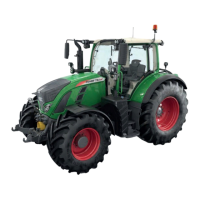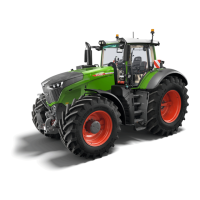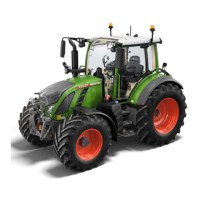2.4.3 Bleeding air from the fuel system
IMPORTANT:
Do not open any fuel injection lines while bleeding the system, otherwise they will have to be replaced.
Bleeding air from the fuel system
1.
Open bleed screw (B) on the fuel pre-filter.
2.
Unlock the manual feed pump (A). To do this,
press in the manual feed pump and turn anti-
clockwise.
3.
Switch the thermal valve (C) clockwise so
that no air can be sucked in from the return.
4.
Keep pumping with manual delivery pump
(A) until a strong resistance is felt; pump on
for a few strokes after this.
5.
Close bleed screw (B) for the fuel pre-filter.
6.
Return the thermal valve (C) to the default
position.
7.
Lock the manual feed pump (A) again.
8.
Start engine.
NOTE:
Air in the high-pressure system may result in
unacceptable pressure fluctuations in the
common rail system. Therefore run the
tractor under low load for about 5 minutes.
Fig. 18
2.4.4 Change the AdBlue® filter
DANGER:
Serious chemical burns through contact with AdBlue® fluid: The AdBlue® fluid contains
uric acid. Contact with AdBlue® fluid irritates the mucous membranes, particularly those
in the eyes, nose and throat as well as other skin. Small quantities can cause burning and
streaming eyes and irritation of the throat; larger quantities can cause chemical burns to
the eyes and throat. Ensure that no children are in the proximity of AdBlue®. Ensure that
no AdBlue® gets into the eyes and mouth or comes into contact with skin or clothing.If
contact with the skin does occur, wash the affected area of skin in clean water
immediately.If AdBlue® has been swallowed, rinse out the mouth immediately with
plenty of clean water and then drink plenty of water. Seek medical attention.
DANGER:
Irritation through contact with AdBlue® vapors: The AdBlue® fluid releases ammonia
vapors when it evaporates. Contact with these vapors, for example when opening the
AdBlue® tank cover at high temperatures, irritates the mucous membranes, particularly
those in the eyes, nose and throat as well as other skin. This may cause burning and
streaming eyes and irritation of the throat. Do not inhale any escaping AdBlue® vapors.
Ammonia vapors can generally be recognised from their characteristic odor.
2. Service and maintenance
30 Maintenance
530.020.020.011 Rev.A

